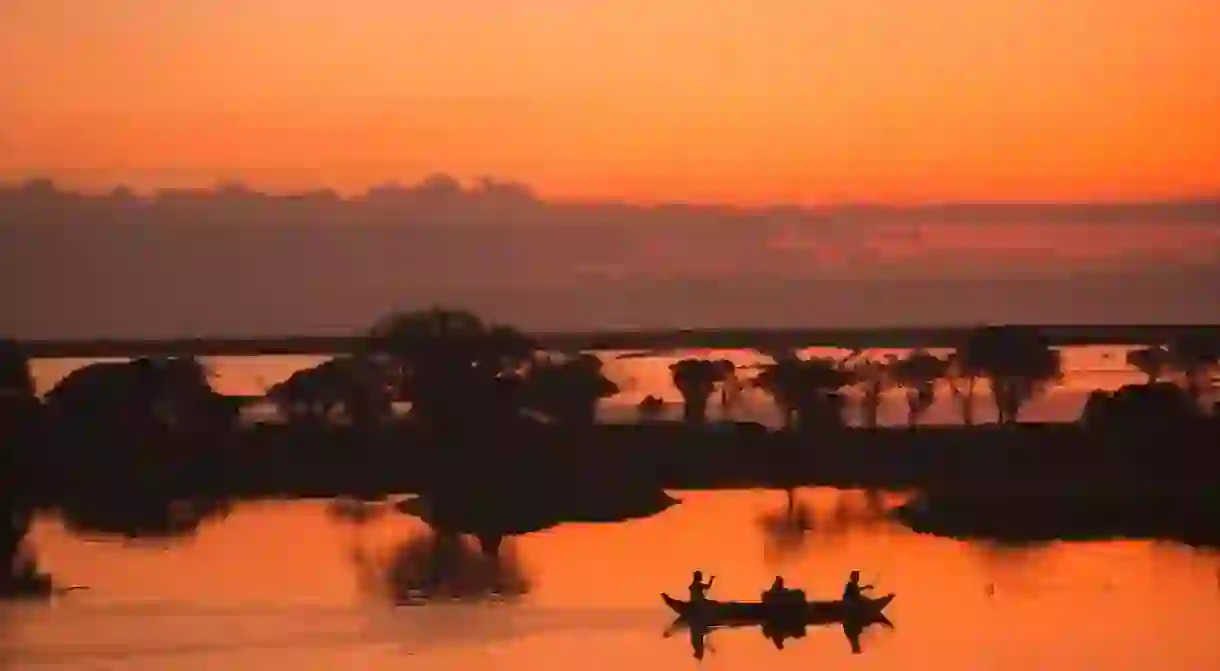A Guide to The Tonlé Sap River

The Tonle Sap River is the lifeblood of Cambodia, pulsing through the country from Siem Reap to Phnom Penh. This natural phenomenon is also the only river in the world whose tide changes annually. Here is everything you need to know about the Tonle Sap.
Thin wooden fishing boats gently slice through the water, a web of nets trailing in their wake. Fishermen sit hunched at the bow, waiting to anchor at a prime spot to catch a good haul. On the banks, water buffalos wade through flooded fields flanked by shimmering emerald paddies occasionally punctuated by the silhouette of a stilted house.

These are common scenes to be found along the Tonle Sap River, which despite its 120km length is an almighty force. Branching off the Tonle Sap Lake, the river pumps life throughout Cambodia, with its fish providing more than 50% of the population’s protein intake. Be it fish for food and trade, water for farming, or nutrition for fertile land, this great ecosystem is pivotal to life in the country.
The Great Tonle Sap
The Tonle Sap River connects the Tonle Sap Lake with the Mekong River in Phnom Penh, and has played a huge part in civilisation for centuries. Water from the lake supplied the Khmer Empire’s population, all the way back from when Angkor Wat stood as the capital in the 12th century to today, feeding the livelihoods of swathes of Cambodians.
With fishermen landing more than 400,000 tons of fish out of the Tonle Sap Lake annually, it is Southeast Asia’s largest freshwater lake. In 1997 it was designated a UNESCO biosphere reserve. The lake also stands as one of the richest inland fishing areas in the world, home to 149 fish species including (despite its name), the Mekong giant catfish.

Hundreds of bird species nest at the Tonle Sap Lake, 11 of which are globally threatened and six are near-threatened species. Many can be found at Preak Toal Core Reserve, run by Sam Veasna Center. These include painted storks, greater adjutants, grey-headed fish eagles and the masked finfoot.
A remarkable natural phenomenon
What makes the Tonle Sap even more remarkable is that the flow of the river changes direction every year. During monsoon season, swelling waters from the Mekong River (which meet the Tonle Sap in Phnom Penh), hammer against the Tonle’s flow. The might of the Mekong is so strong that it reverses the flow of the water, pushing it back upstream and into the lake.
This incredible natural phenomenon sees the lake rise by up to tenfold in some places, where the water increases from one to 10-metres deep. As dry season creeps in and the water starts to ebb, the Tonle Sap flows back towards the capital, significantly emptying out the lake.
The annual Water festival, or Bon Om Touk, displays the significant role the Tonle Sap plays in the lives of locals. This three-day festival takes in colourful boat races on the Tonle Sap in Phnom Penh, including celebrations, concerts and fireworks, marking the end of monsoon season and welcoming in the harvest moon. It also celebrates the reversal of the Tonle Sap River.
Floating villages
It isn’t just nature that calls the Tonle Sap Lake home – settlements of floating villages also dot the expansive mass of water. Predominantly ethnic Vietnamese, these communities live out their lives on the lake. Floating schools, clinics, temples and houses bob on the water, accessible only by boat.
With many of the villages inflicted by poverty, tourism has become a tool to provide them with a sustainable form of income. Today, several of the villages can be visited as part of community-led boat tours, sunset cruises, homestays and other initiatives. Kampong Phluk, home to about 5,000 residents, is one of the most popular on the tourist trail. Kampong Khleang is another alternative that is more off the beaten track.

Troubled waters
Grave fears have been raised over the future of the Tonle Sap, and what this spells for Cambodians. Environmental issues such as climate change pose a threat, alongside manmade challenges such as over-fishing, deforestation, agriculture, mining and dam construction.
Fears over the Tonle Sap’s future are so grave that environmentalist organisations are calling for urgent measures to be taken to save the waters that Cambodians rely so heavily on.













